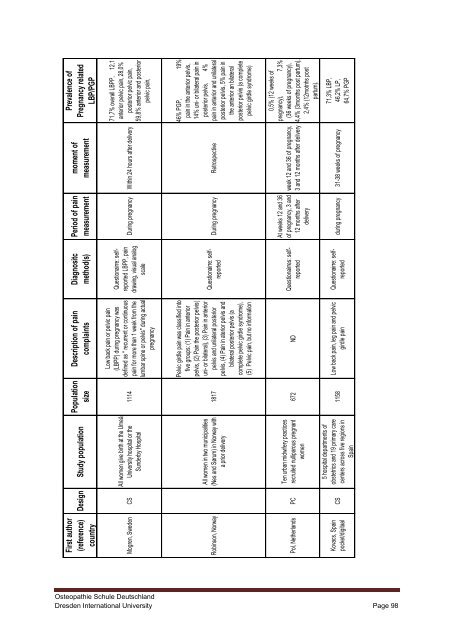Pelvic girdle pain and relevance of ASLR testing: A ... - Cindy Verheul
Pelvic girdle pain and relevance of ASLR testing: A ... - Cindy Verheul
Pelvic girdle pain and relevance of ASLR testing: A ... - Cindy Verheul
Create successful ePaper yourself
Turn your PDF publications into a flip-book with our unique Google optimized e-Paper software.
Prevalence <strong>of</strong><br />
Pregnancy related<br />
LBP/PGP<br />
moment <strong>of</strong><br />
measurement<br />
Period <strong>of</strong> <strong>pain</strong><br />
measurement<br />
Diagnositc<br />
method(s)<br />
Description <strong>of</strong> <strong>pain</strong><br />
complaints<br />
Population<br />
size<br />
Design Study population<br />
First author<br />
(reference)<br />
country<br />
71,7% overall LBPP, 12,1<br />
anterior pelvic <strong>pain</strong>, 28,0%<br />
posterior pelvic <strong>pain</strong>,<br />
59,8% anterior <strong>and</strong> posterior<br />
pelvic <strong>pain</strong>,<br />
During pregnancy Within 24 hours after delivery<br />
Questionairre: selfreported<br />
LBPP, <strong>pain</strong><br />
drawing, visual analog<br />
scale<br />
Low back <strong>pain</strong> or pelvic <strong>pain</strong><br />
(LBPP) during pregnancy was<br />
defined as " recurrent or continuous<br />
<strong>pain</strong> for more than 1 week from the<br />
lumbar spine or pelvis" during actual<br />
pregnancy<br />
1114<br />
All women give birth at the Umeå<br />
University hospital or the<br />
Sunderby Hospital<br />
Mogren, Sweden CS<br />
46% PGP, 19%<br />
<strong>pain</strong> in the anterior pelvis,<br />
14% uni- or bilateral <strong>pain</strong> in<br />
posterior pelvis, 4%<br />
<strong>pain</strong> in anterior <strong>and</strong> unilateral<br />
posterior pelvis, 5% <strong>pain</strong> in<br />
the anterior an bilateral<br />
posterior pelvis (a complete<br />
pelvic <strong>girdle</strong> syndrome)<br />
During pregnancy Retrospective<br />
Questionairre: selfreported<br />
<strong>Pelvic</strong> <strong>girdle</strong> <strong>pain</strong> was classified into<br />
five groups: (1) Pain in anterior<br />
pelvis, (2) Pain the posterior pelvis(<br />
uni- or bilateral), (3) Pain in anterior<br />
pelvis <strong>and</strong> unilateral posterior<br />
pelvis, (4) Pain in aterior pelvis <strong>and</strong><br />
bilateral posterior pelvis (a<br />
complete pelvic <strong>girdle</strong> syndrome),<br />
(5) <strong>Pelvic</strong> <strong>pain</strong>, but no information<br />
1817<br />
All women in two municipalities<br />
(Nes <strong>and</strong> Sørum) in Norway with<br />
a prior delivery<br />
Robinson, Norway<br />
0,5% (12 weeks <strong>of</strong><br />
pregnancy), 7,3%<br />
(36 weeks <strong>of</strong> pregnancy),<br />
4,4% (3months post partum),<br />
2,4% (12motnhs post<br />
partum).<br />
Ten urban midwifery practices<br />
recruited nulliparous pregnant<br />
women<br />
Osteopathie Schule Deutschl<strong>and</strong><br />
Dresden International University Page 98<br />
week 12 <strong>and</strong> 36 <strong>of</strong> pregnancy,<br />
3 <strong>and</strong> 12 months after delivery<br />
At weeks 12 <strong>and</strong> 36<br />
<strong>of</strong> pregnancy, 3 <strong>and</strong><br />
12 months after<br />
delivery<br />
Questionairres: selfreported<br />
672 ND<br />
Pol, Netherl<strong>and</strong>s PC<br />
71,3% LBP,<br />
46,2% LP,<br />
64,7% PGP<br />
during pregnancy 31-38 weeks <strong>of</strong> pregnancy<br />
Questionairre: selfreported<br />
Low back <strong>pain</strong>, leg <strong>pain</strong> <strong>and</strong> pelvic<br />
<strong>girdle</strong> <strong>pain</strong><br />
1158<br />
5 hospital departments <strong>of</strong><br />
obstetrics <strong>and</strong> 19 primary care<br />
centers across five regions in<br />
S<strong>pain</strong><br />
CS<br />
Kovacs, S<strong>pain</strong><br />
pocket/digitaal


